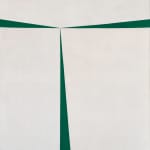Carmen Herrera (1915-2022)
To: P.M., 1967
Acrylic on canvas
45 x 40 inches (114.3 x 101.6 cm.)
Signed, dated & titled ‘Carmen Herrera 1967’ “To: P.M.”’ on the stretcher







